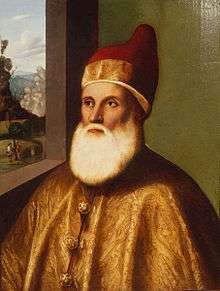Agostino Barbarigo
Agostino Barbarigo (3 June 1419 – 20 September 1501) was Doge of Venice from 1486 until his death in 1501.
Agostino Barbarigo | |
|---|---|
 | |
| Doge of Venice | |
| In office 1486–1501 | |
| Preceded by | Marco Barbarigo |
| Succeeded by | Leonardo Loredan |
| Personal details | |
| Born | June 3, 1419 Republic of Venice, Italy |
| Died | September 20, 1501 (aged 82) Venice, Italy |
| Military service | |
| Battles/wars | Ottoman–Venetian War (1499–1503) |

While he was Doge, the imposing Clock Tower in the Piazza San Marco with its archway through which the street known as the Merceria leads to the Rialto, was designed and completed. A figure of the Doge was originally shown kneeling before the lion of Venice on the top storey below the bell but this was removed by the French in 1797 after Venice had surrendered to Napoleon.[1][2]
In 1496 he created an Italian coalition to push back Charles VIII of France from Italy, which led to the Battle of Fornovo during the French retreat from Italy. During his reign Venice gained several strongholds in Romagna and annexed the island of Cyprus.
His relationships with the Ottoman sultan Bayezid II were initially amicable, but they became increasingly strained starting from 1492, eventually leading to open war in 1499. The Venetian merchants in Istanbul were arrested, while Bosnian troops invaded Dalmatia and reached Zara. The Venetian fleet was defeated at the Battle of Zonchio, and the Republic lost its base in Lepanto. The latter was soon followed by Modone and Corone, which meant the loss of all the main intermediate stops for the Venetian ships sailing towards the Levante.
After four years of war, a peace treaty was signed in 1503. By it, Venice maintained in Morea only Nafplion, Patras and Monemvasia.
His dogaressa was Elisabetta Soranzo.[3] Agostino's brother was Marco Barbarigo, who had preceded him as Doge but survived in office for less than a year;[4] their tomb, originally in the church of the Carita, has been demolished. Part (a relief of the Resurrection of Christ) is in the Scuola di San Giovanni Evangelista, attributed to the workshop of Antonio Rizzo.[5]
Popular culture
- Agostino Barbarigo appears as the doge-elect for his brother Marco in the video game Assassin's Creed II.[6] Marco's short reign as Doge is ended when Ezio assassinates him. In Facebook game Assassin's Creed: Project Legacy it is discovered that Agostino became corrupt, and is subsequently killed by the Assassins on 20 September 1501 via a series of poison-coated letters.
See also
References
| Wikimedia Commons has media related to Agostino Barbarigo. |
- Howard, Deborah (2002). The Architectural History of Venice (Revised & enlarged ed.). Yale University Press. pp. 146–149. ISBN 0300090293.
- Lorenzetti, Giulio (1975). Venice and its Lagoon (English ed.). Trieste. pp. 141–142.
- Staley, Edgcumbe: The dogaressas of Venice : The wives of the doges. London : T. W. Laurie
- Norwich, John J. (1983). A History of Venice. Penguin Books. p. 363. ISBN 0140066233.
- Lorenzetti, Giulio (1975). Venice and its Lagoon (English ed.). Trieste. p. 614.
- Yoyonoa (1 August 2012). "Assassin's Creed - Séquence 1: Entre réalité et fiction !". Gameblog (in French). Retrieved 11 January 2019.
| Political offices | ||
|---|---|---|
| Preceded by Marco Barbarigo |
Doge of Venice 1486–1501 |
Succeeded by Leonardo Loredan |